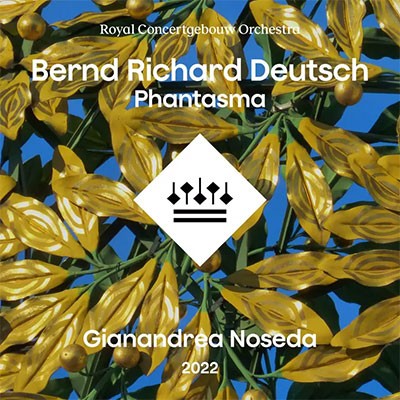3(II,III=picc).3.3(III=bcl).3(III=dbn)-4.3.3.1- timp-perc(3):I=glsp/5tom-t/5tpl.bl/wdbl/tam-t/tgl/II=crot/t.bells/3cyms/metal chimes/timbales/finger cym/claves/tgl/ratchet/III=vib/2bongos/conga/BD/tgl-2harp-cel-strings(14.12.10.8.6)
Abbreviations (PDF)
Bote & Bock
In Akira Kurosawa’s film Dreams, there is a fascinating episode: the visitor to a van Gogh exhibition steps into the pictures, which seem to come alive, as it were, and finds himself in a landscape that resembles that in the pictures.
Ultimately, he encounters in it the painter himself.
In Phantasma, I pursue a similar idea. I have attempted here to delve musically into the pictorial world of Gustav Klimt. During the intensive occupation with Klimt’s work, the contemplation of several of his paintings directly evoked musical ideas and tonal concepts in me. The abundance of figures and ornaments that partially led him to the threshold of abstraction seems to have predestined his visual imagery for musical associations.
The famous tripartite Beethoven Frieze, one of the most important works of his “golden” period, is representative of Klimt’s philosophy of art, and it contains a number of motifs that appear frequently in his works. Thus, for example, the hovering female figures in the Water Serpents, which exist in two versions, and the motif of the kiss, which Klimt depicted several times, appears here, too.
In his program for the frieze, Klimt oriented himself on Richard Wagner’s interpretation of Beethoven’s Ninth Symphony. It reads:
Left wall:
The longing for happiness. The sufferings of weak mankind: their petition to the well-armed strong one as external, compassion and ambition als inner driving forces that impel him to take up the struggle for happiness ...
Middle wall:
The hostile forces. Typhoeus the giant, against whom even gods fought in vain; his daughters, the three Gorgons. Illness, madness, death. Lust and lechery, intemperance. Gnawing grief. The longings and wishes of mankind fly away over them ...
Right wall:
The yearning for happiness finds appeasement in poetry. The arts lead us over to the ideal realm in which alone we all can find pure joy, pure happiness, pure love. Choir of the angels of paradise. “Joy, lovely spark of the gods”; “this kiss of the whole world!”
Reflected in this program is Klimt’s understanding of art, and that of the Viennese Secessionists, which aimed at the total aestheticization of life and eventually salvation through art.
I was not concerned with musically retelling this order of events, but rather to let myself be inspired to a very personal interpretation by Klint’s representation. The dramatic essence of the frieze, as a structural framework, very much accommodated my ideas.
In a biography of Gustav Klimt, I read that, in order to attain admission to his atelier, one had to knock on the door in a specific, previously agreed rhythm. I immediately had the idea for the beginning of the piece: it opens with a kind of knocking signal in the claves over slow string chords. This is followed by the main theme of the piece, which is played by a few woodwinds accompanied by percussion instruments as well as by a violin solo over a harmonic ten-tone constellation, which I call the “golden chord.” These two elements, the theme and the chord, pervade the piece in continually new variations.
The following first section, titled “The yearning for happiness,” is predominently hovering and lyrical: the music intensifies to a first passionate outburst only toward the end. It leads into the second part, “The hostile forces,” which is of dramatic character. The giant Typhoeus, a monster from Greek mythology, the Gorgons surrounding him, and further obscure figures are the protagonists of this section. The dramatic aspect, which is linked to these figures, is atypical for Klimt’s work. The representation of negativity rarely occurs in his works, but it was all the more important to me for musical-dramaturgical reasons.
In the third section, “... into the ideal realm.” the music increasingly develops an ecstatic-eruptive character and ultimately leads to a repetition of the passionate outburst from the end of the first section, which however this time leads to an almost triumphal climax.
This is followed by a Coda that again takes up the knocking signal and the string chords of the opening in a modified form.
Everyone has probably experienced that shortly before waking up in the morning, sounds from the surroundings can become part of a dream. In analogy to this phenomenon, the piece ultimately shows itself, through the recurring knocking motif at the end, to be a dream vision or illusion – a Phantasma.
Bernd Richard Deutsch, 2022 (translation: Howard Weiner)
Bernd Richard Deutsch’s Phantasma, which has been travelling widely since its premiere in 2022, traces its origins back to Beethoven’s Ninth Symphony. This is through a double filter of Wagner’s influential interpretative essay on the symphony, and Gustav Klimt’s remarkable revisualising of that essay in his Beethoven Frieze at the Secession Building in Vienna. The three sections of Deutsch’s score match the panels of Klimt’s triptych. On the left wall is “The yearning for happiness”, in the centre is “the hostile forces” and on the right “... into the ideal realm”. The composer is not so much concerned with musical storytelling but rather finding the dramatic basis for each panel to create illusory dream visions. Knocking signals to start and close the piece provide a blurred interface between the waking world and the inner Phantasma of the title.
"Phantasma is a dream-like fantasy on Gustav Klimt's Beethoven Frieze... [Deutsch] reflects its surface and surreal invention in a swirling kaleidoscope of sound."
The Times
"Deutsch's imaginative use of large orchestra provides some atmospheric sounds, a musical equivalent of Klimt’s sumptuous use of colour. The dramatic centre of the work clearly relates to the struggle of the “genii” of the frieze to pass the monster Typhoeus and other hostile forces. Throughout there were delicate motifs and rich harmonies which drew the listener into the piece."
Bachtrack

Royal Concertgebouw Orchestra /
Gianandrea Noseda

